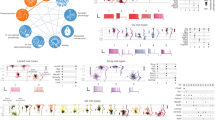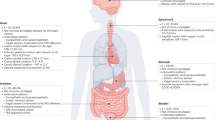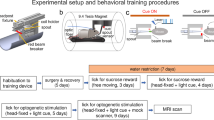Abstract
Replying to N. K. Logothetis Nature 468, 10.1038/nature09532 (2010)
This is a welcome opportunity to discuss ofMRI, a technology for testing the causal and global impact of defined cell populations in vivo1. The accompanying Comment2 reviews well-known neuroanatomy, but does seem, in its entirety, to be founded on a suggestion that, after experiments were conducted to drive a defined circuit element and measure resulting BOLD signals1, we concluded that no other contributory circuit element was recruited by the driven population. This was not the case, however, as correctly understood by others in the fMRI community3,4,5 and as explained in the paper (for example, “contributions from additional cells and processes downstream of the defined optically triggered population are expected and indeed represent an important aspect of this approach”1). Moreover, the complexity of the brain dictates that such possible contributory mechanisms are more numerous than listed in the Comment2, including many other circuit and feedback mechanisms and classes of cells within neural circuitry6,7,8,9,10. As was discussed1, this is one of the most important and useful aspects of the ofMRI approach.https://www.nature.com/articles/nature09532
Similar content being viewed by others
Enjoying our latest content?
Log in or create an account to continue
- Access the most recent journalism from Nature's award-winning team
- Explore the latest features & opinion covering groundbreaking research
or
References
Lee, J. H. et al. Global and local fMRI signals driven by neurons defined optogenetically by type and wiring. Nature 465, 788–792 (2010)
Logothetis, N. K. Bold claims for optogenetics. Nature 468, 10.1038/nature09532 (2010)
Leopold, D. A. fMRI under the spotlight. Nature 465, 700–701 (2010)
Palmer, H. S. Optogenetic fMRI sheds light on the neural basis of the BOLD signal. J. Neurophysiol. 104, 1838–1840 (2010)
Vanzetta, I. & Slovin, H. A. BOLD assumption. Front. Neuroenerg. 2, 5 (2010)
Iadecola, C. & Nedergaard, M. Glial regulation of the cerebral microvasculature. Nature Neurosci. 10, 1369–1376 (2007)
Hamel, E. Perivascular nerves and the regulation of cerebrovascular tone. J. Appl. Physiol. 100, 1059–1064 (2006)
Cauli, B. et al. Cortical GABA interneurons in neurovascular coupling: relays for subcortical vasoactive pathways. J. Neurosci. 24, 8940–8949 (2004)
Devor, A. et al. Stimulus-induced changes in blood flow and 2-deoxyglucose uptake dissociate in ipsilateral somatosensory cortex. J. Neurosci. 28, 14347–14357 (2008)
Gordon, G. R. C., Choi, H. B., Rungta, R. L., Ellis-Davies, G. C. R. & MacVicar, B. A. Brain metabolism dictates the polarity of astrocyte control over arterioles. Nature 456, 745–750 (2008)
Schneuwly, S., Klemenz, R. & Gehring, W. J. Redesigning the body plan of Drosophila by ectopic expression of the homoeotic gene Antennapedia . Nature 325, 816–818 (1987)
Petreanu, L., Huber, D., Sobczyk, A. & Svoboda, K. Channelrhodopsin-2-assisted circuit mapping of long-range callosal projections. Nature Neurosci. 10, 663–668 (2007)
Gradinaru, V. et al. Targeting and readout strategies for fast optical neural control in vitro and in vivo . J. Neurosci. 27, 14231–14238 (2007)
Author information
Authors and Affiliations
Rights and permissions
About this article
Cite this article
Lee, J., Durand, R., Gradinaru, V. et al. Lee et al. reply. Nature 468, E4–E5 (2010). https://doi.org/10.1038/nature09533
Published:
Issue date:
DOI: https://doi.org/10.1038/nature09533



